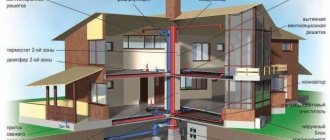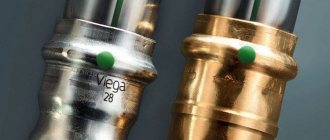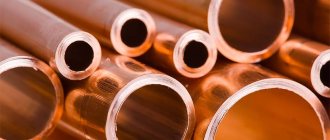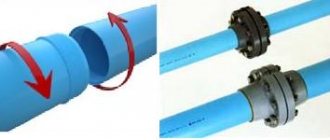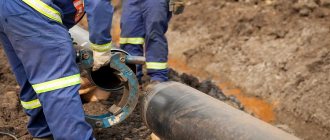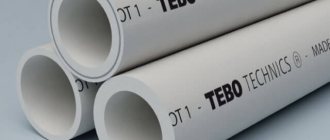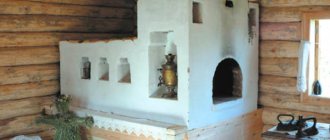Installation of heating pipes is an important stage of construction work, on which the comfort of living in the house depends. Ideally, the heating system is installed during the construction of the house before the finished object is delivered, but in practice it is often necessary to reinstall the system from scratch. For example, having bought an old house or cottage, the new owner wants to modernize all the engineering systems in the house and completely dismantles the pipes. In this case, you have to re-develop the project taking into account the specific layout of the building, calculate heat losses, draw up estimates, purchase materials and perform installation.
Types of connections
Modern communications can be installed from metal, plastic, metal-plastic, PVC, HDPE and other pipes.
The material of manufacture determines the choice of method for connecting the risers into a single structure. Therefore, elements of the pipeline system can be of collapsible and non-demountable types. Among the many detachable joints, connections both with and without threads are equally popular. Threaded methods include connections using:
- bends, couplings, locknuts;
- American women with a union nut;
- bidirectional threads.
The threadless method includes jointing using:
- flanges;
- welding;
- compression fittings.
and other devices, depending on the material used to make the pipes.
We will talk about these types of connections in more detail later.
Malleable cast iron and connecting parts made from it
The most common ductile iron parts for connecting steel pipes and other pipeline parts are: A) straight couplings B) reducing couplings C) coupling nuts D) fittings E) locknuts E) plugs.
To completely seal the system with a threaded connection, it is necessary to use sealants, for example, gaskets. In addition to them, for other types of fastening additional parts are used. If it is necessary to connect the elements of the pipeline using flanges, that is, without a coupling, then in addition to gaskets, bolts are also needed.
When connecting risers at an angle, they use connecting parts made of ductile cast iron: straight and transition angles, tees, crosses.
A cast iron coupling has a low collar around the entire perimeter of the end circumference, which serves to increase the strength of the part, unlike its steel counterpart, which does not have such an element.
The quality of connections depends not so much on the sealing methods and materials, but on the craftsman and the quality of his work. If he is responsible, neat, has basic plumbing knowledge and skills in working with a wrench or pipe wrench, then you won’t find a better specialist. If you follow the basic rules for installing pipeline systems, the pipeline will function for many years. This can be confirmed by anyone who has at least once installed a pipeline system, even the shortest and simplest one.
Try it yourself, experiment and see that you are the best specialist in installing pipeline systems using the threaded method of connecting pipeline elements.
Connection in heating system
The industry produces pipes from various materials. These products are used for laying water pipes, sewers, gas pipelines, and other pipeline communications.

When laying heating systems, pipes from:
- become;
- copper;
- plastic.
Depending on this, risers in heating structures can be connected using:
- welding;
- threaded fittings;
- flanges;
- press connections;
- compression and push-on fittings,
- and other ways using innovative modern technologies.
Differences from compression analogues
Due to inexperience and ignorance of all the nuances of installing metal-plastic pipes, press fittings can be confused with compression fittings. They also have a fitting and a sleeve. Only the latter is crimped not with a tool, but using the union nut included in the design.
The main difference between these parts is the different type of connection resulting from installation. The compression version can be disassembled if necessary, but this cannot be done with a pressed version. The press fitting can only be cut off from the pipe to be replaced with a new one.
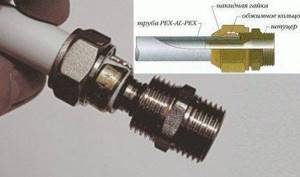
If a leak develops at the connection point, the nut of the compression fitting can be tightened, but the maintenance-free press fitting will have to be completely removed (+)
However, the likelihood of a leak in the press connection is practically zero. It is not for nothing that this installation method is recommended for use when installing heated floors under screed and when embedding pipelines into the wall.
Cases when such fittings begin to leak in concrete occur extremely rarely in the practice of plumbers. This is more of an exception to the rule.
On the other hand, installation of both types of press fittings requires specialized tools. And to tighten the nuts of compression products, you only need a pair of wrenches.
As a result, on one side of the scale there is “expensive tools + higher reliability of the joint”, and on the other “no extra expenses + a slightly higher risk of leaks”. The choice here is only up to the master and the owner of the house where the pipeline is being laid.
Threaded fastening of copper pipes
Steel pipes have long dominated the installation of heating systems. Gradually they began to be replaced with products made from other materials.
Today is the time for copper and plastic pipes. They are connected using soldering, compression and press fittings. But the threaded connection in the heating system of metal pipes practically remains a priority among all types of joints.
Threaded connections are used not only when laying heating pipes, but also when fastening steel, including galvanized water risers.
In gas pipelines and especially in high-pressure pipelines, welding is used as a connection.
Articulation using threaded fittings is characterized by:
- speed of assembly;
- high quality, reliable connections;
- Possibility of installation in hard-to-reach places.
Important! Using a threaded coupling, bends, locknuts, elbows, and taps, you can not only quickly dismantle, but also assemble the pipeline.
Without fittings with internal and external threads, it is impossible to properly install a pipeline from copper risers. To install these system parts, it is necessary to have threads not only on the connecting elements, but also on the ends of the risers. All measuring instruments are connected using fittings.
When installing copper pipes, American pipes are often used, which is rightly considered one of the types of threaded connections.
Important! When using copper pipes for hydraulic systems, remember that copper does not combine well with other metals and alloys, since upon contact a chemical reaction occurs that can destroy the elements of the heating circuit.
How to attach metal-plastic pipes to walls
Good fastening of metal-plastic communications extends their service life. When heated, pipes elongate and may “lead”; in addition, poorly and sparsely secured communications are more susceptible to vibration, which has a bad effect on the reliability of the connection. Therefore, metal-plastic pipes must be securely fastened. The clamps must be close to the fitting.
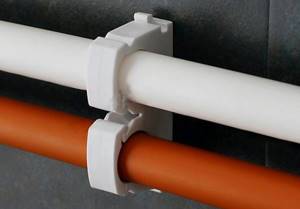
Fastenings are placed in increments of 0.7-1 m, for heating and hot water supply - 0.5-0.7 m. The stores are full of all kinds of clips and clamps of all diameters. You can also use homemade brackets. Fasteners are attached to concrete walls with 6x40 mm dowels, to plastered, gas or foam concrete walls - 6x60 mm or even longer.
Gas
For decades, gas lines were installed using seamless metal pipes. Under the influence of corrosion, their service life is significantly reduced. This factor was one of the reasons for replacing metal pipes with products made from other materials
:
- polyethylene;
- copper;
- of stainless steel.
Each type of pipe can be joined in different ways. Is it possible to connect gas pipes with a threaded connection?
and if so, what materials are the risers fastened with threads from? Yes, you can. For example, threads are used to connect steel and copper products.
When joining gas pipes, a threadless method is also used.
In particular:
- soldering can be used to joint copper or polyethylene pipeline parts;
- welding is successfully used when laying steel and copper lines. For example, steel elements can be welded with an autogen or arc welding machine;
- Main pipelines are installed using flange fastenings. In addition, flanges are installed at those points of the pipeline system at which there is a branch from the main gas pipeline to the house or apartment.
Types of tools for installing metal-plastic pipes
The following tools are used to connect metal-plastic pipes:
- Pipe cutter or scissors for cutting metal-plastic.
- Angle grinder (grinder).
- Pipe bender
- Construction hairdryer.
- Hand press or press tongs.
The grinder and hair dryer are driven by an electric motor. Household pipe benders for metal-plastic pipes are usually manually driven. The manual crimping press has several varieties with different types of drives.
Mechanical
Manual or mechanical mini pliers are used for crimping water pipes with a diameter of up to 20 mm. These are used for internal distribution of hot and cold water. These tools do not have an electric drive or hydraulic boosters; human muscle power is used to operate them.
Manual drive
Manual pipe benders and homemade Volnov machines have a more complex design than simple tools. The force required for bending is quite significant, and levers are used to operate such structures.
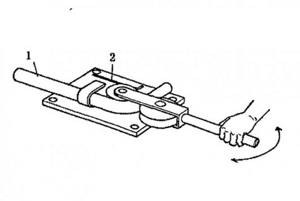
To crimp metal-plastic heating pipes (25 mm, sometimes 32 mm), use a standard manual press for crimping press fittings. To enhance a person’s muscular strength, a gear drive is used, and it also helps to correctly adjust the crimping force.
Hydraulic
For crimping larger diameter pipelines (up to 32 mm), hydraulic models of pliers are produced. A reinforcing hydraulic cylinder is built into one of the pliers handles. When the handles are compressed, the pressure in the hydraulic cylinder increases and the force is transferred to the crimping head of the pliers. Such pliers are quite expensive (from 10,000 rubles), they require qualified maintenance.
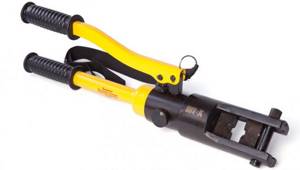
Electrohydraulic option
All previous models are used for the installation of metal-plastic engineering systems in small volumes. In industrial construction or if you constantly install plumbing systems, it makes sense to purchase a powerful electro-hydraulic pressing tool. Such equipment is used for installation of pipelines with a diameter of up to 108 mm.
Electro-hydraulic pressing tools have high productivity and the highest quality and tightest compression. The devices are equipped with nozzles for crimping pipes of different diameters. Electric pliers for household running diameters up to 50 mm can be powered by batteries.
Metal
Metal pipelines transport gas, water, steam, household waste, and other working media.
When laying individual sections, permanent connections are used:
- welding;
- carving;
- soldering
Detachable joints include
flanges, bends, union nuts. They are used in systems that are frequently dismantled.
Metal risers are used when laying water and gas pipelines. To connect using a thread, you must use a drive, a coupling, or a lock nut.
Copper pipes are connected using soldering. Such joints are characterized by increased reliability.
Both threadless and threaded types of pipe connections come in collapsible and non-separable types.
Can a threaded device be non-separable, you say?
Yes maybe. There are situations when 2 pipes are connected with threads and then welded to fixed structures. This is an example of a permanent type thread fastening.
Threaded coupling
An interesting type of joint was joining using a bidirectional thread
. Such a connection is made with a threaded coupling by simultaneously screwing it onto both risers, if the pipes being connected have multi-directional threads. Therefore, before making a threaded connection of such pipes, you need to once again make sure that there are different thread directions on the risers.
The main thing is to choose a good seal. Can be sealed with silicone. Although many people use the old proven method, using FUM tape or sealing thread and oil paint.
Detailed description of each method
Threaded
They can be done in several ways, the most common being squeezing.
The following tools will help you do this job:
- Pipe wrench.
- Coupling with internal thread.
- Seals for sealing. Maybe: hemp rope, FUM tape or sealant.
- Lock-nut.
Two pipes have external threads. We apply sealant to them. One has a longer thread length than the other. Where there are more turns the nut is screwed on until the end. Then the clutch. Then we screw it onto the second part, twisting it with the first one. When the coupling stops screwing, support it with a lock nut
Tighten with keys, carefully, so that the coupling does not burst
Flanges
For a flange joint you will need:
- two flanges;
- paronite gasket;
- bolts, washers, nuts;
- keys;
- manual arc welding;
- level.
The flanges need to be welded. Avoid displacement; they must be in the same plane.
We catch using a horizontal level. We screw two bolts into the upper holes. We put the part on the edge of the tube so that the bolts are at the top. We put a level on them and catch the position of the bubble between the strips in the middle. When caught, we make a tack by welding at the top point. The horizontal plane is ready.
We rearrange the level to a vertical position, leaning it against the flange mirror. We catch the level by slightly adjusting the lower end of the flange that is not yet stuck. Having established the vertical, we installed the second tack. And then two more, resulting in four even sections.
Then the welder welds the flange on both sides. Manipulations are carried out similarly with the second pipe.
Bonding
This method is used very rarely in metal parts. The process itself does not require any special skill from a person, but it takes a lot of time.
This job requires:
- glue. BF-2 or 88N or EDP;
- brush.
Before gluing the parts, first apply the first layer on their surface and allow to dry. This layer will be the bonding layer. Each glue has a drying time written in its instructions. Then a second layer is applied and the parts are placed under the press for a day or even more. It all depends on the glue.
Then clean the seam from any glue leaks.
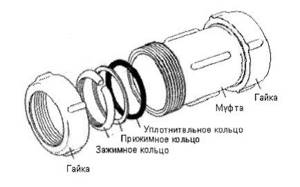
Crimp connectors for steel pipes
Welding
The welding process is used in almost all metal pipe joints.
In order to obtain a seam, the following welding methods are used:
Gas welding is used to obtain permanent connections in small diameter pipes with minimal thickness.
The gas welding station consists of:
- oxygen cylinder;
- acetylene;
- rubber hoses;
- burners.
Resistance welding is rarely used. This method has proven itself more effective in working with plastic pipes.
The most popular method of producing permanent joints is electric arc welding, divided into:
- manual
- semi-automatic in protective gas environment
When constructing pipelines, connections are made only by welding
An important part is preparing the joint for welding
The pipe must be connected to another:
- no fractures or displacements;
- the joint must be cleaned;
- make a chamfer;
- set the gap to 1-3 mm.
Required welding equipment:
- electrodes;
- power source (transformer or rectifier);
- cable;
- Personal protective equipment for welders: overalls, mittens, brushes.
Soldering of polyethylene pipes end-to-end and using an electrofusion coupling
Trumpet
This type of connection is widely used in cast iron pipes for the oil and gas industry, housing and communal services. One of the simplest options for permanent joints.
The main process of obtaining a joint is to seal the gap between the socket and the surface of the conical pipe. Cement material is used for this.
To seal the socket, grade 300-400 cement is used, which is thoroughly mixed with water in a ratio of nine parts cement to one part water. The socket is filled with cement mortar using a scoop and embossed until the latter begins to bounce off the cement.
Pressing
This method of obtaining a permanent weld has become necessary for small-diameter connections made of non-ferrous metals. Conventional electric arc welding is not capable of welding such metals due to its technical parameters, so in this case they found a different approach.
To join such thin-walled non-ferrous metal pipes, press fittings with crimp sleeves are used. They perform crimping on the inside of the pipe, and external seals ensure the joint is sealed.

Galvanized
Zinc is one of those metals that do not corrode. Therefore, you cannot think of better protection for steel pipes from moisture.
The galvanizing process involves coating the internal and external surfaces of the riser with zinc. The service life of such a pipeline is determined by the quality of the coating and the thickness of the applied metal layer.
Galvanized risers are connected by threading or welding. Many people believe that galvanized pipes are generally prohibited from being used for laying water pipes. But that's not true. The fact is that such risers are not recommended for transporting hot water.
But the use of products to supply the home with cold water does not pose any danger to the human body. The main thing is that the drinking pipeline is used constantly, and the water does not stagnate in the pipes. Then the presence of zinc in such a liquid will be about 5 mg/l, which is below the maximum permissible concentration per day (the norm is 12-15 mg/l).
Important! The degree of zinc concentration can be determined independently: if the presence of zinc is elevated, then the water has an astringent taste.
Galvanized riser
Galvanized risers are used to lay an autonomous water supply system. They are used to construct wells, although GOST does not foresee the use of such risers as casing pipes.
The fact is that the water exchange in the well is small, which does not exclude the possibility of deterioration in the chemical composition of the water. Plus, under the influence of the soil environment, if the joints are not reliably sealed, electrochemical corrosion is possible.
Therefore, when asked whether it is necessary to seal the threaded connection of the casing pipe
The answer is clear: yes, it is necessary.
When screwing a joint, thread sealants are used. The highest quality seals include the RUSMA series seals, which reliably seal and protect threaded connections.
Manufacturers and technical specifications
Italian polypropylene pipes and fittings Valtec (“Valtek”) are produced in three categories: conventional thin-walled, reinforced with fiberglass and foil. At the same time, the manufacturer states that the foil contains 99.4% aluminum. The layers are glued together using adhesives from Japan and the USA, which give a layer strength of 70 N/10 mm at a rate of 15 N/10 mm. The company makes fittings from PP-R 100, which guarantees its durability. There are some design features of Valtec fittings: their sockets are conical in shape, and no bead of molten material is formed during welding. Another nuance: combination fittings (with metal threads) have an octagonal outer shape, which allows you to use standard wrenches when working with them.
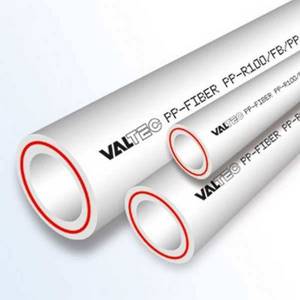
Valtec polypropylene pipes and fittings
The German company Banninger Kunststoff-Produkte GmbH also produces pipes and fittings from random copolymer polypropylene. This raw material is chemically neutral and allows the use of pipelines from this company to supply drinking water. It is worth remembering that Germany has adopted the most stringent safety standards for building materials in the European Union. So, if the Germans are ready to use them to supply drinking water, then there is no doubt about their safety. The only drawback of Banninger polypropylene pipes and fittings may be their rather high price.
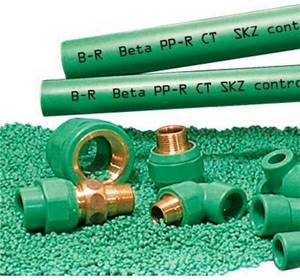
Banninger polypropylene pipes and fittings
The products of the Czech company Wavin Ecoplastic have an impeccable reputation. This is exactly the “eco-plastic” that is of excellent quality, and not fake. Before purchasing what sellers call “eco-plastic”, check the country of origin of the product. If this is not the Czech Republic, then this is one of the crafts, the quality of which is difficult to vouch for. Why are Ecoplastic polypropylene pipes and fittings so good? Because the manufacturer guarantees that they will withstand 20 atmospheres, and only high-quality materials are used for manufacturing. Ekoplastik Stabi - foil-reinforced pipes, Ekoplastik Fiber and Basalt+ are reinforced with basalt fiber. The rest are unsuitable for hot water supply or heating, but are very good for cold water.
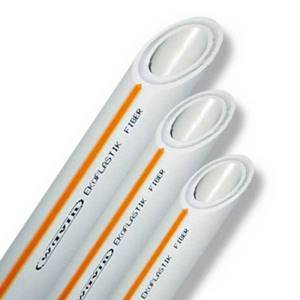
Polypropylene pipes and fittings Wavin Ecoplastic
Polypropylene fittings and Turkish pipes have fairly good reviews on the forums. They have good quality and low prices. Available:
- Simple pipe PN10 and PN16.
- With fiberglass reinforcement (fiber) Kalde PN16.
- Superpipe Kalde - pipes with aluminum reinforcement, but the foil is not solid, but perforated. Therefore, when welding, it does not require stripping or trimming. The manufacturer says that at an ambient temperature of no more than 70°C, the service life of a pipeline made from such elements will be 50 years. For hotter environments the period is reduced.
Naturally, a set of fittings are produced for each type of pipe.
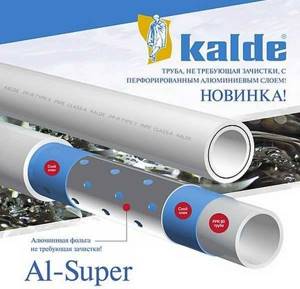
Polypropylene pipes from the Turkish company Kalde with perforated aluminum
Another Turkish manufacturer is Tebo. Polypropylene pipes and fittings of this brand are made from a resistant new polymer Polypropylene Random Copolymer (“Random copolymer” PPR type 3)
This company pays great attention to certification: there are documents of compliance with GOST, DIN and TSE. Product diameters from 20 to 160mm, product types - PN10, PN20, PN25
Solid foil is used for reinforcement, therefore stripping when welding PN25 pipes is required.
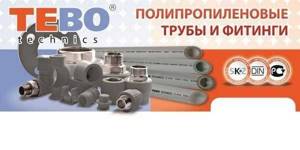
Polypropylene pipes and fittings Tebo
There is another Turkish company SPK on the market. Its products are of fairly high quality, and prices for some products are 50% lower than those of European manufacturers. In this case, raw materials are used from Holland, and the equipment at the factories is German. The quality of SPK pipes and fittings is high: they can withstand operation in Siberian conditions, which is a fairly compelling argument in favor of this campaign.
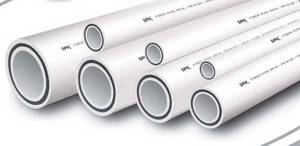
Polypropylene pipes and fittings SPK
These are not all manufacturers, but they are the most frequently used and have decent quality.
Metal-plastic
Old metal pipes that have served for a long time are usually replaced with metal-plastic ones. This replacement is due to the presence of a number of positive characteristics that metal-plastic has in comparison with other materials.
It is different:
- long service life;
- ease of installation;
- reliability and durability;
- low cost;
- the ability to function in a wide temperature range: from -8⁰С to +95⁰С, which makes it possible to use it for heating systems.
Metal-plastic risers can be articulated:
- using compression fittings;
- using press fittings.
Before connecting, it is necessary to draw a drawing of the placement of risers, plumbing fixtures, and control devices.
Then you need to take accurate measurements and cut off the necessary pieces of pipe and lay them out along the future pipeline. To prevent burrs and roughness from remaining on the ends, clean the ends with a sharpened drill or round file. Use a calibrator to straighten the deformed edges and the pipe is ready for installation.
Popular makes and models
Banninger brand products
The Germans are considered one of the most popular manufacturers of fittings. These include companies:
- Banninger - pipes and connections made from environmentally friendly materials that do not change the taste of water and its chemical properties. All products have the necessary strength and lightness, do not rust or become clogged during operation, do not transmit vibration and do not break when frozen.
- Aquatherm – German quality and full compliance with certificates. The connections of this company have a wide range of applications; they can be used in heating, any water supply and even in shipbuilding.
- Wefatherm - pipes and connections fully satisfy all the requirements for pipelines for a wide variety of purposes. This company produces products from new generation materials, for example, glass fiber reinforced polypropylene. Such pipes and fittings have minimal thermal expansion; no stripping is required during assembly (reduces installation costs).
- Ecoplastic is a Czech company that sets a quality standard. Its products are not inferior to German ones, and prices are much lower. The declared service life of pipes and fittings is 50 years.
- TEVO, a Turkish manufacturer of polypropylene products, has been competing in the market with the Czechs and even the Germans for several years. Large range of pipes and connections for them.
- BLUE OCEAN and Dyzain are Chinese in the polypropylene products market. In general, the quality of manufacturers from this country is not very high, but these two have proven themselves well. Their products have the necessary characteristics. A special advantage is the low cost. Among the disadvantages, there are some difficulties during installation.
- PRO AQUA, RBK, Santrade, Heisskraft, Polytek are domestic manufacturers of polypropylene products, the quality of which is not inferior to foreign ones. The main advantage of Russian companies is that only their products can withstand a pressure of 70 atm; accordingly, they will have the longest service life.
Pvc
Statistics say that when repairing utility networks, about 75% of old risers are replaced with PVC (polyvinyl chloride) pipes. The laying of new communications is also most often carried out using PVC risers. Why is their popularity growing so much?
The fact is that:
- The installation of the main line can be done by yourself. This fact distinguishes risers from similar products made from other materials;
- their cost is quite affordable, which helps save significant money;
- products are durable and reliable;
- the structures are resistant to corrosion processes, which contributes to a long service life.
You can join PVC pipes using:
- bells In this way, sewer risers are connected, and rubber rings act as a seal. They can be lubricated with anaerobic sealant, which will significantly enhance the sealing process;
- flanges Such fastening is indispensable in the presence of pipelines that are subject to disassembly associated with frequent periodic maintenance work. This applies to temporary mains, to pipelines that are often moved;
- thermistor type welding, which is used when joining pipes with diameters of 20 mm or more. In addition, cold welding (adhesive bonding) is often used. The procedure is carried out using a special glue, which should be applied with a brush along the entire length of the inner surface of the fitting and along the circumference of the pipe.
Important! Before cold welding, it is necessary to chamfer the ends of the bonded risers at an angle of 15 degrees. To carry out the procedure, chamfered incisors are used.
Technology of using press fittings
Connecting copper or XLPE pipes requires the following tools:
- scissors for cutting plastic pipes (steel products are cut using a grinder);
- chamfer;
- calibrator;
- tape measure, marker;
- press jaws for the corresponding fitting profile.
It is rational to use press pliers for connecting small-diameter pipes (up to 26 mm); for crimping large-sized products, an electrically driven tool is required - a press gun, with the use of which crimping a fitting takes no more than 5 seconds. You also cannot do without a press gun if you are working on connecting steel pipelines, the crimping of which requires increased effort.
Installation of cross-linked polyethylene pipes is carried out according to the following algorithm:
- Using a pipe cutter, the pipe is cut at a right angle to its axis (the tightness of the connection directly depends on the accuracy of the cut - the end part of the pipe must fit tightly to the fitting body).
- An internal chamfer is cut on the pipe cut using a chamfer remover. The ovality of the end formed during cutting is removed with a calibrator.
- A fitting crimp sleeve is placed on the pipe, after which the pipe is pushed onto the fitting until it stops.
- Using pliers or a press gun, the sleeve is crimped.
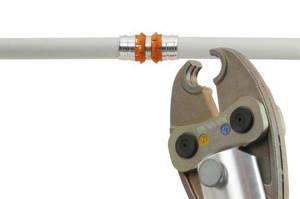
If the installation is performed correctly, after crimping, pronounced rings form on the sleeve, which indicate the tightness of the connection. Please note that crimping a fitting can only be done once; if the connection is defective, you must cut off the part of the pipe on which the press fitting is attached and repeat the installation using a new product.
Features of selection and review of manufacturers
Press fittings are supplied to the market by a fairly large number of manufacturers; they are represented in the assortment of every company that sells cross-linked polyethylene pipes and metal-plastic products. Having studied consumer reviews and the opinions of specialized experts, we will highlight two companies - Henco and Tiemme.
Henco is a Belgian company, one of the market leaders. The company produces two types of press fittings - Henco PK and Henco PG. The PG series features standard brass products with a protective galvanized coating, while the PK press fittings have a PVDF (polyvinylidene fluoride) polymer body. Fittings from Henco are produced for pipelines made of cross-linked polyethylene with a diameter of 16, 20, 26, 32 and 40 mm.
Brass products can be used in hot water supply and heating systems (temperature maximum +115), while PVDF press fittings are intended for cold water supply pipelines.
Tiemme is an Italian manufacturer whose product range includes press fittings of the following series:
- Tiemme Cobra - a line of fittings for cross-linked polyethylene pipes;
- Tiemme 1650 - press fitting for reinforced metal-plastic pipes;
- Tiemme 2670 – press fittings for metal-plastic pipelines transporting gas.
The Tiemme fitting body is made of brass, the crimp nut is made of stainless steel. The maximum temperature of the products is +95 (short-term temperature +110), they can withstand pressure up to 16 Bar. Diameters – from 15 to 63 mm.
When choosing press fittings, beware of fakes, of which there are quite a lot on the market - pay attention to the weight (brass fittings are massive, low weight indicates that some cheap alloy is being passed off as brass), the thickness of the crimp sleeve and the markings (the letters must be engraved , and not applied with paint). Tools for installing fittings - press pliers - are also presented in the range of these companies
Henco pliers (the set includes attachments for press fittings with a diameter of 16 and 20 mm) will cost you 15 thousand, from Tiemme - 14 thousand rubles. However, the pliers from the Italian company are designed for use with pressing guns, while the tool from Henco is used for manual crimping
Tools for installing fittings - press pliers - are also presented in the range of these companies. Henco pliers (the set includes attachments for press fittings with a diameter of 16 and 20 mm) will cost you 15 thousand, from Tiemme - 14 thousand rubles. However, the pliers from the Italian company are designed for use with pressing guns, while the tool from Henco is used for manual crimping.
Polypropylene
Risers with a diameter of less than 63 mm are fastened using socket or socket welding. To do this, use an additional element - a coupling. For threaded or other joining of risers, fittings with sockets are used.
In the case of joining risers 63 mm in diameter and above, butt welding is used. If the appropriate fittings are available, then you can use sleeve welding. When it is necessary for the fastening to be dismountable, flanges are used.
Using a special welding machine and attachments for it, you can reliably and quickly connect polypropylene or polyethylene pipes. Using such a device, risers with a diameter of 16-40 mm are fastened. Non-stick Tiflon is used to cover the nozzles, which makes it possible to make connections of the highest quality.
Classification of fittings
Polypropylene pipes and connecting elements are created from materials with different compositions. Therefore, they are characterized by thermal stability. This material property affects the classification and labeling of fittings and pipes.
Marking
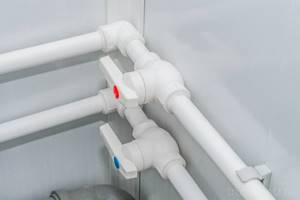
PP pipes and fittings
PP pipeline parts are made from the following raw materials:
- Homopropylene is designated by the abbreviation PPG, and products made from it are marked PRN or PP-1.
- Random copolymer or static copolymer of polypropylene - abbreviated as PPR; when marking pipes and fittings the following designations are used: PP-3, PPRC, PPCR.
- Block copolymer (PPV) - for marking PP pipeline elements, the following abbreviations are used: RRV, RR-S, RR-2.
- Polyphenyl sulfide (PPS) - pipe parts made from it are marked (PPS).
The composition of the PPG material includes modifying additives that increase the impact strength of PP products. In addition, nucleators, fire retardants and substances that reduce static electricity.
Homopropylene is used to make pipes and fittings for external cold water supply networks, drainage and ventilation systems. The products are not used to create heating circuits for buildings because they have a low melting point.
Pipe parts made from PPG are often manufactured with large diameters. Therefore, they are used in drainage and sewer systems for industrial purposes.
Structure
The PPR material is distinguished by the crystalline structure of its molecules. Products made from random copolymer can withstand impacts and temperatures from -170°C to +1400°C.
Pipe products from this raw material are produced with a diameter of 16-110 mm. It is used for installation of heating, sewer and water supply systems in households and industrial facilities.
The PPV material is distinguished by its structure, consisting of precisely ordered homopolymer micromolecules forming blocks. Block copolymer products are characterized by high resistance to impact and high temperatures.
Therefore, heating systems in private houses and apartments are made from it. DHW and cold water circuits.
Polyphenyl sulfide has a different molecular structure and is a high-class polymer. As a result, they are characterized by excellent wear resistance, resistance to heat and heavy loads.
PPS pipes and fittings are created with a diameter of 20-1200 mm for water supply, ventilation and heating. PP products also differ from each other in their MRS characteristic - minimum duration of strength.
The indicator takes into account the wall thickness and allows you to select products based on the highest pressure in the network. Consequently, it will ensure reliable operation of the system for 50 years when moving water at a temperature of 20°C.
The maximum permissible pressure is indicated by the letters PN along with numbers. Thus, PN10 pipe elements can withstand the highest pressure load of 10 bar, and PN16 - 16 bar.
Plastic
Electrofusion welding
Docking of plastic pipes is carried out using:
- diffuse welding;
- carving;
- flanges;
- glue;
- fittings;
- electrofusion welding.
When installing sewerage from plastic pipes, they can be connected into a socket. The connection is quite effective when used in low pressure pipelines, such as the above sewer system.
An excellent option for fastening plastic pipes is cold welding. The essence of its effect on connecting risers is that the glue dissolves the upper part of the plastic of the pipe, thus ensuring adhesion of the risers at the molecular level. Simple, high quality, reliable.
An effective and relatively inexpensive way to connect plastic pipes is a fitting connection. If you need to fasten plastic pipes to metal ones, the easiest way to do this is to use a fitting joint.
For collet fastening, crimp-type fittings are used. The joint is formed in the place where the teeth of the metal riser cut into the main element.
Compression fittings
When installing a water supply system yourself, it is preferable to use compression products, since their installation does not require the use of special tools. The connection in this case is carried out by compressing the walls fixed to the fitting fitting with a union nut.
The design of the compression connector consists of the following components:
- housings;
- fitting - support sleeve. on which the PEX pipe is mounted;
- a ferrule ring acting as a sealing element;
- union nut.
Compression fitting design diagram
The body, fitting and nut are made of brass, a corrosion-resistant metal. the sealing ring is made of EPDM (synthetic rubber). High-quality compression products can withstand a pressure of 25 bar of fluid circulating through the pipeline.
A connection with a compression fitting is a service - if necessary, you can eliminate any leaks by tightening the union nut, but keep in mind that a pipeline connected by compression cannot be embedded inside concrete walls and ceilings, since even with an ideal installation of the fitting, the need for its maintenance will arise after 4-5 years operation of the system.
Compression fitting installation technology:
- The pipe is cut, burrs are removed from the edge using a chamfer, and the ovality that occurs during cutting is eliminated using a calibrator.
- The crimp ring and union nut are put on, the ring is placed at a distance of 1 cm from the cut.
- The pipe is pushed onto the fitting (all the way), the nut is screwed on by hand, and then pulled out using an open-end or adjustable wrench.
Installing a compression fitting
Press fittings
A press fitting consists of a body, a fitting and a compression sleeve. To install it, you will need to use press pliers, which can be purchased for 3-5 thousand rubles, with an attachment selected in accordance with the profile of the sleeve. There are no universal fittings that can be crimped with any pliers - each manufacturer has its own standard.
The connection of cross-linked polyethylene pipes with press fittings is not maintenance-free; if leaks occur, you will need to completely replace the problem area, however, a pressed joint has maximum reliability and durability - subject to the temperature and pressure conditions specified by the PEX pipe manufacturer, it will last at least 30 years.
Installation of press fittings is carried out according to the following algorithm:
- Trimming the pipe, cleaning the edges from burrs and eliminating ovality with a calibrator.
- Fitting the pipe onto the fitting fitting.
- Crimping the crimp sleeve with pliers - the tool handles are brought together until they stop.
The quality of the connection is indicated by the appearance of two distinct rings on the sleeve.
Welded fittings
The most reliable and durable way to connect cross-linked polyethylene products is the high-temperature soldering method, which uses fittings made of the same material as the main part of the pipeline.
The essence of the method is to melt the walls of the connecting structures and their subsequent joining, resulting in the diffusion of materials, which after hardening provides a monolithic connection that is resistant to high pressure and leakage.
Welded fittings for polyethylene pipes can be cast or segmented. The differences between them are that cast structures do not have connecting seams, while segment fittings are made by factory soldering individual sections of pipe, which is why they have less strength and, at the same time, a lower price.
To solder PEX pipes, you need a special soldering iron equipped with nozzles of a size corresponding to the diameter of the pipes you are working with. The cost of such a soldering iron varies between 2-10 thousand rubles, the kit includes nozzles for pipes with a diameter of 16, 20, 25 and 32 mm; if necessary, larger nozzles can be purchased separately.
Connecting polyethylene pipes by soldering
Technology for soldering polyethylene pipelines:
- The pipe is cut, calibrated and deburred.
- Nozzles of the required diameter are installed on the soldering iron.
- The tool is heated to a temperature of 220 degrees.
- The pipe and fitting are put on the nozzles and the heating time is maintained, which depends on the diameter and wall thickness of the pipes: for 16 and 20 mm - 5 sec, 25 mm - 7 sec, 32 mm - 8 sec, 40 mm - 12 sec.
- The products are removed from the attachments and joined together. The connection cooling time is 2 minutes.
PE pipes of large diameters (over 60 mm) are butt welded, without the use of shaped structures.
Drilling and high pressure pipelines
Using drill pipes:
- lift the rock cutting tool;
- rotation is transmitted;
- axial loads are transferred to the tool;
- flushing liquid is supplied.
Therefore, the load on such a structure is quite large. The connection of drill risers is carried out using drill joints, which have a special locking thread.
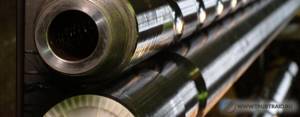
To make the structure more durable and operate for a long time, anti-corrosion grease is used to protect the lock threads. The threads are also protected by applying metal safety elements to the connecting points.
One of the most complex technological operations is the process of designing and installing high-pressure pipelines. The specifics of operation do not allow the possibility of interruptions in the operation of the pipeline. Otherwise, an emergency situation may arise. Therefore, the risers must be securely fastened using high-quality sealing of threaded connections.
High-pressure pipelines can transport gas, steam, and liquids over long distances. The pressure in the transport system can reach 25 atm and higher.
To lay pipelines, pipes made of steel (carbon and alloy), copper, and plastic (mainly polyethylene) are used. The fastening of pipes to each other can be of detachable and permanent types.
Important!
When installing a high-pressure pipeline, you need to strive for a minimum number of detachable-type connections. This is due to the need for increased safety when transporting the working environment. The following are rightfully considered to be fairly reliable permanent fastenings:
- seam welding;
- fusion welding;
- soldering.
Subtleties of installing a crimp coupling
In a situation where the thread on a pipe has rotted and cutting it is impractical, a universal solution would be to install a crimp coupling.
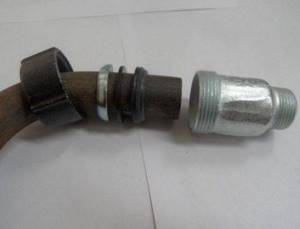
Installing a crimp coupling is a win-win option in situations where you need to join pipes or connect equipment without involving threads
To correctly install the compression fitting, installation is performed in the following order:
- The pipe section to be joined is cleaned of burrs, treating both the outer and inner surfaces of the product.
- The end of the pipe is inserted into the fitting body, positioning it in such a way that the central part of the coupling strictly corresponds to the joint.
- A crimp ring is pulled onto the pipe.
- A crimp nut is placed on the resulting segment. As the nut moves along the thread, it will press the ferrule into the pipe, creating a tight connection.
When tightening the nut, do not use excessive force. Otherwise, the nut will compress the connection or simply burst.
Thread sealant and sealing
In places where pipeline elements are connected, liquid can flow and gas can escape. To protect yourself from such situations, seal the threaded connections of pipes with thread sealant. The product may look different, but its purpose is the same - to seal joints.
Teflon tape
Among the many sealing materials we can highlight:
- Teflon tape, which is the simplest sealant;
- mastic or red lead paint in combination with tow. This seal has been used for several decades, and is still relevant today;
- sealants containing special solvents.
Important! Choose a high-quality seal that will provide a reliable threaded connection, which is especially important when laying gas pipes.
A one-component paste is also used, with which you can easily achieve reliable sealing of not only threaded, but also other types of fittings and risers.
Important! Work with this sealant is accompanied by quick installation and maximum accuracy. The substance does not shrink and does not pollute the internal cavity of risers.
The great advantage of the material compared to Teflon or tow is that with the help of paste, minimal gaps or cracks in the system are ideally filled, which ensures absolute tightness. This cannot be said about Teflon tape, which can collapse under dynamic loads and contaminate the internal pipe space.
Working with tow is accompanied by some inconveniences in the form of contamination of risers and floors. In addition, it is characterized by strong creep and shrinkage.
Advantages and disadvantages of each method
Thread
Advantages:
- reliability;
- ease of assembly, possibility of disassembly;
- low cost.
Flaws:
- tension in the thread cavities increases material fatigue, reducing its strength;
- the need to use locking means to prevent the working element from unscrewing.
Flanges
Advantages:
simplicity and convenience of reusable connection and disconnection.
Negative properties:
- high labor intensity in manufacturing, therefore, high price;
- with prolonged use, the location of its connection decreases, loss of tightness.
Bonding
The advantages of this method include its not labor-intensive process, which does not require much skill and effort.
But the wait for gluing sometimes reaches three days, which is not always convenient.
This type of connection cannot be considered a reliable method.
Welding
Advantages:
- reliability;
- durability;
- tightness;
- the ability to connect parts of any shape.
Flaws:
- the occurrence of residual stresses;
- possibility of changing geometry;
- risk of destruction under vibration and shock loads.
Trumpet
In comparison with all types, socket pipes have the advantage of low cost, the possibility of small axial and lateral movements of the pipe, which is very useful during temperature changes and soil shrinkage.
The negative indicator lies in the difficulty of connecting the connector and insufficient reliability at high pressure.
Pressing
A common positive factor is excellent self-centering of the joined parts and stable state under shock loads. A simple and non-labor-intensive process.
Cannot be disassembled or dislodged from each other. Here are a few disadvantages of this method.
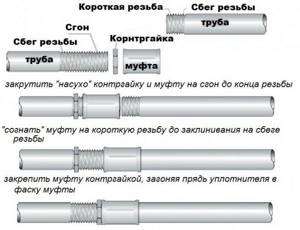
Methods for connecting metal pipes
Couplings
When repairing gas and water supply systems or laying new ones, the question arises: what is the best way to connect risers and seal the resulting joints.
If we are talking about detachable connections, then it is best to connect the risers using couplings. They can be used both in the form of connecting parts and as adapters if the linear dimensions, including the diameters of threaded pipe connections, are different.
Important!
When choosing a fitting, remember that pipes and couplings must be made of the same material. The couplings differ:
- reliability;
- availability and breadth of assortment;
- speed, ease of assembly and disassembly;
- low cost.
Depending on the types of risers, similar connecting fittings are produced. The sealant is selected in the same way. If metal fittings are most often sealed with tow and oil paint, then for plastic parts FUM tape and synthetic sealant, in particular anaerobic sealant, are best suited.
Options for laying out the heating pipeline in the house

There are two types of installation - open and hidden. An open network is installed along the bottom of the walls, a closed one can be recessed into the floor screed. The choice of method depends on the requirements of the owner and the skill of the craftsman. If the installation technology is followed, the network performance parameters are not reduced.
But there are some nuances that need to be resolved first:
- The laying technique depends on the material of the pipes for the circuit. For example, steel elements have a minimal thermal expansion rate. This property allows you to embed the contour into the screed and wall it without much risk. The risk of leakage due to deformation or rupture is minimal. The metal-plastic circuit has a significant linear expansion, so it is better not to hide such pipes in the walls and floor.
- High-quality pipeline insulation will reduce heat loss. The winding will prevent the risk of rupture of the circuit walls in the event of strong linear expansion.
Most often, craftsmen choose an open layout option. But only when we are not talking about the contours of a warm floor.
Hidden styling

The pipeline is laid out in the walls, floor or rises to the ceiling with installation behind a suspended or hemmed finish. It is most convenient to carry out work on hidden layout during a major overhaul or at the construction stage of the facility.
Features of the formation of hidden contours:
- a minimum number of joints, turns, bends - such networks are less at risk of deformation and leakage;
- accessibility of connection areas for inspection and preventive maintenance;
- Old heating pipes cannot be hidden in the floor screed.
In order not to forget all the details of the arrangement, it is recommended to draw up a detailed technical plan for the heating system. This diagram will help you quickly find the main line shutoff unit if the heating pipes in the floor screed leak.
Open display
Laying heating pipes in an open way is the simplest and most affordable option for a home craftsman. The complexity of the circuit or the number of turns does not matter here - with the correct selection of the section, performance does not decrease.
Additional benefits of an open network include:
- Low cost of work. Due to the absence of additional sleeves and other elements, the costs will not be so impressive.
- Possibility of quick renovation and repair. All details remain visible, restoration will not take much time.
Features of connecting profile pipes
Profile pipes have good strength and relatively low weight, so they are often used for the installation of frame structures, as well as for other construction purposes.
The shape of profile pipes can be:
- rectangular (the most common shape);
- square;
- ovoid (oval);
- others (more complex forms).
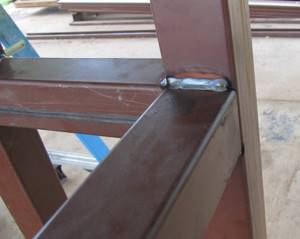
The most reliable way to create structures from profile pipes is to fasten them by welding
Electric arc welding is usually used to connect square pipes. There are also special connections that are made using bolts and rivets. Square and rectangular pipes are joined using the same methods.
In addition, various parts can be joined to such pipes. This joining is carried out using self-tapping screws. These elements do not require preliminary holes.
DIY heating installation step by step
In those houses that have been in operation for many years without repairs, the heating systems have become clogged with a wide variety of deposits, pipes and radiators. In this regard, heating efficiency has decreased significantly, which has led to a deterioration in living comfort. Therefore, today, for those who live in such houses, any repairs begin with the replacement of radiators and pipes, or with a complete modernization of the system as a whole. In addition, very often apartment owners in new buildings prefer to make certain changes to the heating system to improve the quality of heating.
Modernizing a heating system is a rather complex and time-consuming undertaking that requires a responsible approach. Therefore, in most cases, apartment owners prefer to entrust all work to professionals. But among them there are also those who are ready to master the technology and modernize the heating system on their own.
In any case, the procedure is as follows:
- Coordination of the work with the Housing Office, which will ensure the discharge of water in the system and its shut-off;
- Coordination with neighbors on the time of work related to the replacement of risers below and above the ceilings;
- Dismantling components of the old heating system;
- Hanging radiators in designated places;
- Thread cutting on risers;
- Assembly of pipelines and connection of radiators;
- System testing.
Radiator installation
Most often, modernization of the heating system is carried out using polypropylene pipes. And the main issues are always related to the installation of radiators.
Regardless of what type of radiator you plan to install, you first need to prepare a place for its installation. As a rule, heating batteries are installed under windows to ensure high-quality air convection.
If the external walls were insulated using a heat insulator installed on a metal frame, then the thickness of the walls increased significantly. Therefore, it is necessary to accurately determine the distance from the supporting base on which the battery will be located. Difficulties always arise when attaching a radiator to drywall, especially when hanging cast iron radiators. In this regard, it is better to first prepare the base for hanging radiators, that is, sheathe the wall with a special frame. And if the walls are plastered from scratch and leveled, beacons should be installed.
inserts from OSB or plywood should be installed in the places where the brackets are mounted
approximately
25 mm
, which fit inside
the UD profile
and their lower part rests on the floor.
To hang each radiator, you will need 2 or 3 such inserts, if 4 or 6 brackets are used, respectively. As a rule, 6 brackets
are used to hang
cast iron radiators
that have
more than 10 sections
.
After carrying out preliminary operations related to preparing the base for hanging radiators, it is necessary to mark the mounting brackets. To do this, the radiator is installed in the design position on a temporary stand, and then leveled using levels. As a rule, it is placed in the center of the window opening at a distance of 10-15 cm from the finished floor and 10 cm from the window sill
.
Next, holes for the brackets are made in the marked places using a hammer drill. The mounting brackets are screwed in so that there is a gap of 3-4 cm
.
Using plugs for piping an installed radiator
As a rule, all heating radiators are sold with four open inlets, a pair on each side. This is due to the fact that during installation different methods of connecting heating devices can be used, namely:
- One-sided;
- Lower;
- Cross;
- Single-pipe.
Therefore, during the installation of radiators, some of the inlets are closed with plugs, and others with pass-through plugs with ½ or ¾ inch threads. The procedure for tying a radiator is one of the most important jobs, since very often leaks occur on low-quality threaded connections.
Most often, when installing a heating system in apartments, one-way connection of batteries
which is considered the most effective.
This option provides for the supply of coolant from above the radiator, and the return is organized on the same side from the bottom of the heating radiator. On the opposite side, a Mayevsky valve is installed
to ensure air discharge, and the lower inlet is closed with a plug.
Using the example of the above described method of connecting a radiator, it becomes clear that to install the battery you need to purchase a kit consisting of four plugs
: three through and one blind.
The plugs differ in the direction of the thread and are selected in accordance with the threads at the radiator inlets. In addition, they can be ½ or ¾ inch in diameter
. For the twentieth pipe, you should choose half-inch plugs, and if the supply is carried out by the 25th pipe, when a single-pipe heating system is being installed and the radiator is a component of the riser, you should take ¾-inch plugs.
Remember not to use
When screwing in the plugs,
there are no sealing gaskets
, and the plugs themselves are screwed in with noticeable force. At the same time, it is necessary to thoroughly clean even new radiators from any deposits of paint, rust or scale.
Installing taps on a radiator
shut-off and control valves are installed in them
. These can be ordinary ball valves. To allow manual adjustment of the coolant flow, you can install radiator taps, and for automatic adjustment, special taps with thermal heads are used.
The most commonly used are so-called American taps with union nuts.
, they allow you to quickly and easily turn off the water, as well as remove the radiator if necessary. They create convenience when, during the repair process, batteries are hung on a rough wall, which will later be plastered, puttied, etc. The advantage of an American tap is that it can be used repeatedly, regardless of the type of gasket used, since the sealing is carried out solely due to conical metal parts. There are angle and straight taps, and which one to install depends on where the inlet pipes approach the radiator.
To install the American valve into the radiator passage plug, a special key is used
. It is inserted into the tap pipe and can have a cross-section of any shape, the main thing is to choose the right size. If there are a couple of protrusions inside the tap, then you will have to select the key profile for a better hook. Sometimes the jaws of an adjustable wrench or pliers are used to install the faucet.
The connection of the passage plug with the branch pipe of the American tap must be additionally sealed by winding. Moreover, FUM tape is suitable only if the thread is made of high quality, there are no sharp corners on it and there is a special notch that prevents the sealing material from twisting. UNIPAK sealing paste to seal the joint.
.
It is first necessary to check the threads of the tap and the passage plug for compatibility by connecting them without a sealant. This will also help determine the required winding thickness. After all, excess thickness can lead to cracks and various deformations of thin-walled parts. A thin layer can cause leakage.
The threads are sealed in the opposite direction to the direction of the threads on the faucet pipe. The flax fibers are wound tightly from the beginning of the outer edge, and it is necessary to prevent their scrolling by pressing each previous layer tightly. Having filled the thread to its full depth with winding, lubricate it with paste and screw the part into place.
If metal ball valves are used, then threaded couplings are screwed onto them to ensure the transition to polypropylene. And in this case, winding is also used. The Maevsego tap is equipped with a rubber gasket, so it does not require sealing.
After packaging is completed, the radiator is hung in a certain place.
Installation of supply pipeline
There are two widely used heating systems:
- Single-pipe;
- Two-pipe.
When replacing radiators and pipes in a separate apartment, you should not make changes to the working heating circuit in order to avoid any problems with the heat supplier or neighbors.
In typical apartments built in Soviet times, most often, a single-pipe heating system
. This option provides for the supply of hot water from top to bottom along a riser, from which radiators installed in series are powered through tees, crosses or “explosion”. As a rule, each room of the apartment has a separate riser. The main disadvantage of such a heating system is that it is almost impossible to regulate the temperature of the heating devices. In addition, radiators on the lower floors are significantly colder in comparison with heating devices installed on the upper floors.
The two-pipe system is most often installed in private houses, as well as in new buildings. This system uses a pair of pipes, one of which is designed to supply heated coolant, and the second, which is called “return”, allows the cooled coolant to be removed. In this case, heating devices are connected in parallel, which allows you to set the required temperature of the radiators using coolant flow regulators, which are installed on the supply line.
Selection of pipes for heating installation
Today, the market offers pipes for heating systems made from a variety of materials at different prices. They should be selected taking into account operating conditions. It is also necessary to take into account the quality and composition of the coolant, its pressure and temperature. In addition, an important selection criterion is the installation method: hidden or open. Care should be taken to ensure that the parameters of the pipes are compatible with the characteristics of other elements of the heating system.
polypropylene pipes are the most popular when installing heating systems.
, which are characterized by good performance.
The main advantages of polypropylene pipes include the following qualities:
- Corrosion and chemical resistance;
- Low thermal conductivity;
- Smoothness of the inner surface;
- No impact on the coolant;
- Affordable price;
- Easy to install.
There are several different types of polypropylene pipes, which differ in purpose. The main parameter that you should pay attention to is the pressure that the pipes can withstand. Therefore, it is important to take into account the value that is represented by the PN marking
.
PN25
pipes with a reinforcing layer are suitable for heating , which reduces the coefficient of linear thermal expansion.
In addition, reinforcement reduces the permeability of pipe walls, which means it prevents the penetration of oxygen, which causes corrosion processes. Plastic pipes used for heating are reinforced with fiberglass
mixed with polypropylene.
This colored layer is applied in the middle of the pipe and is clearly visible on the cut
.
When connecting reinforced pipe to fittings, aluminum foil close to the surface must be removed by hand repair to ensure quality. It should be noted that this process takes quite a long time. Pipes that have a fiberglass layer do not require stripping.
Diameter of polymer pipes for heating systems
The goal of correctly selecting pipes for arranging a heating system is to ensure its correct functioning while using the least amount of coolant. And this is understandable, because an unjustifiably increased diameter of pipes will lead to excessive consumption of coolant, and therefore an increase in the cost of heating. But the reduced diameter of the pipes will reduce the pressure of the coolant and significantly worsen the quality of heating. In heating engineering, the diameter of pipes is calculated using complex hydrodynamic formulas, the main initial data for which are:
- Direct pipeline diagram;
- Parameters of the radiators used;
- Features of the coolant;
- Working pressure in the system.
When replacing radiators and pipes, there is no need to use complex hydrodynamic formulas. In practice, it has been verified that to install a single-pipe apartment heating system, pipes with an outer diameter of 32, 25 and 20 mm
.
to use pipes
with a diameter of 32 or 25 mm
for the risers of a vertical single-pipe , and
pipes with
a diameter of 20 mm
the supply to the batteries .
For a two-pipe horizontal system, when choosing the diameter of the pipes, it is necessary to take into account the length of the solid sections, as well as the number of heating devices to be installed. If more than 8 batteries are installed in a specific area, or if its length is more than 30 m
,
a pipe with a diameter of 32 mm
.
With a smaller
number of radiators, a pipe
with a diameter of 20 mm
, and for connecting
single radiators
in areas
up to 10 m,
with a diameter of 20 mm
is sufficient .
How to lay heating pipes?
Today, most apartment owners refuse external heating due to its unaesthetic quality. Therefore, when installing a heating system, work related to gating channels in the floor and walls is mandatory. When organizing a two-pipe horizontal system, the best option is to lay the pipes directly into the floor structure, but in this case it is better to connect the batteries from the walls. You can make wiring in the finished concrete floor by cutting grooves, or lay pipes before pouring the screed.
It is recommended that the supply and return pipelines be installed in separate grooves
, and
the distance between them
must be at
least 100 mm
. Each groove must be of sufficient size to ensure free laying of pipes.
When laying polymer pipes, it is necessary to insulate them with foamed polyethylene to ensure free thermal expansion. Also for the same reason, it is recommended to fill the space near the fittings with some soft material.
The pipeline should not be secured with rigid fasteners; it is better to use movable supports in the form of plastic clamps or brackets that will not interfere with the linear expansion of the pipes. The pipes used must be firmly fixed at the point where they exit the wall.
The routes must be laid perpendicular or parallel to the walls, all turns must be made exclusively at right angles. To bypass previously laid pipes, ready-made bypasses should be used. For polypropylene pipes in frame structures, flexible compensating loops can be used.
Before starting work, it is recommended to first draw up a laying diagram
heating pipes in the floor structure. In addition, in order to exclude possible puncture of the pipe during any subsequent repair work, it is necessary to record particularly difficult areas with laid pipes using a camera against the background of an unfolded tape measure.
, sheet insulation can be laid in the grooves
equipped with a reflective layer. In this case, thermal radiation will be directed inside the room and the effect of a warm floor will be ensured.
When installing a vertical single-pipe system that does not have long horizontal sections, the pipes and riser are usually laid in wall grooves or under a plasterboard covering. You should remember about the mandatory insulation of pipes laid in external walls.
Assembly of polypropylene pipeline
It is recommended to install heating pipes in the direction from the risers to the already connected and hung radiators. You should decide in advance on the place where the last soldering will be done. Such a place should be accessible so that you can easily work with a soldering iron. As a rule, this is the area between the battery and the wall.
Pipes must be prepared according to the number of straight sections provided for in the diagram. The size of each is measured using a tape measure. Special scissors are used to cut pipes
.
It is important to remember that approximately 15 mm of the pipe length is included in the fitting
.
If aluminum-reinforced pipes are used to install the heating system pipeline, their edges should always be first cleared of foil using a special repair.
Compound
cut polypropylene pipes are performed
by thermal welding
using various fittings such as couplings, elbows, tees, loops, crosses, etc. Welding is carried out with a special welding machine equipped with replaceable nozzles. With its help, fittings and plastic pipes are melted at the same time.
Welding is carried out as follows:
- The welding machine is turned on to fully warm up, and the heating process is controlled by a special indicator;
- A pipe cut to size is inserted into the coupling part of a special nozzle; The fitting, together with the pipe, is pushed onto the mandrel until it stops.
To ensure a high-quality weld, the melting time must be maintained correctly. You cannot warm up the plastic too much, since the resulting connection will not be strong and reliable enough, and if you overheat the fitting and the pipe in the nozzle, deformations of the joint surface may occur and the inner diameter of the pipe will narrow, and in some cases even block it. Pipes having a diameter:
- 20 mm is heated for about 5 seconds;
- 25 mm is heated for about 8 seconds;
- 32 mm heats up for about 12 seconds.
When welding pipes, the ambient temperature should be taken into account. If it is below +5ºС, then the heating time of plastic pipes should increase by approximately 50%.
It should also be remembered that the welding machine must be set to the temperature recommended by the manufacturer for welding polypropylene pipes. As a rule, it is in the range of 250-300°C. It is important that when assembling the heating system, pipes and fittings from the same manufacturer are used.
It should also be remembered that in order to obtain strong connections, the heated surfaces of the parts must be dry and clean and dry.
After the surfaces of the plastic components on the welding machine are melted, they are removed from the nozzle. Next, the pipe is quickly inserted into the fitting and this should take no more than 3-4 seconds. After this, it is necessary to securely fix the connected parts in a certain position for 4-6 seconds, without exerting a significant force on the joint. All operations must be carried out carefully and to prevent any distortion of the parts being connected relative to the axis. Do not rotate the parts relative to each other while welding. As the parts cool down they become a single whole. It is allowed to continue the soldering process next to a fresh connection only after the parts have completely cooled.
To ensure that any outlet parts are positioned in a certain direction after soldering, it is recommended to try them on the pipe in a cold state and make marks with a pencil or marker in the form of directional marks. Moreover, the mark on the pipe is made at a distance no closer than 15 mm from the edge, and on the fitting the mark is placed directly next to the joint. This will greatly simplify the connection of parts, since it remains to combine two risks.
To facilitate the process of laying the pipeline, you should schematically mark the plan for laying heating pipes on the floor or on the wall. And even if there are already cut grooves, it is recommended to draw all the necessary fittings next to them. This will allow you to correctly calculate the required amount of materials, as well as accurately produce all the enlarged parts.
When heating parts on the nozzle of the welding machine, you need to ensure that there are no foreign particles on it. If necessary, a clean rag can be used to clean the nozzle. If heated material regularly sticks to the nozzle, this means that the non-stick coating is damaged, which means the welding machine needs to be replaced.
It is absolutely not necessary to assemble the pipeline for the heating system in order, moving in one direction. It is much more convenient to assemble individual enlarged parts and only then connect them together.
The assembly of the heating system pipeline must be carried out by two people, one of whom performs operations with a soldering iron, and the other connects the heated parts. To fix pipes passing through ceilings or walls, you may need the help of another person. Before carrying out welding work, you should first practice on small pieces of polypropylene pipes, and also carefully study the instructions for using the welding machine and the instructions of the manufacturers of pipeline components. All welding work should be carried out with gloves to avoid burns.
Checking the operation of the installed heating system
Upon completion of all installations, the installed heating system must be checked for leaks. To do this, a hydrostatic test is carried out under pressure 1.5 times higher than the nominal
.
But at the same time it should not exceed the maximum permissible
for each of the components used in the system.
The system should be filled with water from bottom to top
.
In the case of a two-pipe horizontal circuit, it is recommended to open the return lines first. The air in the radiators will be forced upward and from there it can be discharged using Mayevsky taps
.
Then, using a pressure test pump, the pressure is raised, which is monitored by a pressure gauge for a significant drop. Be sure to visually check for leaks
at welded and threaded connections.
As a rule, such a check takes no more than half an hour
.
When replacing radiators and installing a heating system, all work must be carried out with extreme care and attention. Any errors can lead to serious destruction and damage. Only full compliance with installation technology in combination with the correct choice of materials can guarantee long-term operation of the installed heating system.
Similar
Connecting profile pipes without welding
Joining of profile pipes can be carried out without the use of welding equipment. How to connect profile pipes without welding:
- use of a crab system;
- fitting connection.
The crab system for pipes consists of connecting brackets and fixing elements. The connection in this case is made using nuts and bolts and ultimately forms an “X”, “G” or “T”-shaped profile structure. With this connection you can connect from 1 to 4 pipes, but only at right angles. They are as strong as welded seams.
A fitting connection is used when it is necessary to make a branch from the main pipe. There are several types of pipe connectors that allow you to mount workpieces in different configurations. The main ones:

Crab systems are most often used when installing simple outdoor structures, such as a greenhouse or shed

